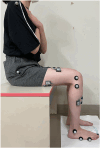Comparing Electromyographic Muscle Activities and Kinematics During Sit-to-Stand Transitions in Patients with Adult Spinal Deformity Versus Healthy Controls
- PMID: 40217963
- PMCID: PMC11989561
- DOI: 10.3390/jcm14072514
Comparing Electromyographic Muscle Activities and Kinematics During Sit-to-Stand Transitions in Patients with Adult Spinal Deformity Versus Healthy Controls
Abstract
Background/Objectives: Adult spinal deformity (ASD) affects sit-to-stand (STS) transitions due to abnormal spinal alignment, influencing muscle function. This study investigated lower-extremity electromyographic activity and kinematic parameters during STS transitions in ASD patients. Methods: A cross-sectional study was conducted with ASD patients scheduled for corrective surgery. The STS task was divided into three phases, and electromyographic activity, temporal parameters, and joint kinematics were compared between ASD patients and controls. Surface electromyography measured muscle activity, and a high-speed camera recorded phase durations and joint movements. Results: Compared to 17 controls, 17 ASD patients exhibited significantly increased %MVIC (ASD, controls, p-value) in the biceps femoris during the flexion momentum phase (23.7 ± 26.5, 12.3 ± 8.6, p = 0.048) and extension phase (48.6 ± 25.8, 32.8 ± 40.5, p = 0.011), and in the soleus during the flexion momentum phase (16.2 ± 7.5, 8.5 ± 2.9, p = 0.001). The ASD group also showed greater joint motion and longer phase durations during STS transitions. Conclusions: ASD patients display increased lower limb muscle activation, prolonged phase durations, and more joint motion during STS transitions. These findings highlight neuromuscular and biomechanical differences, though whether these are pathological, adaptive, or compensatory remains unclear.
Keywords: activities of daily living; electromyography; kinematics; lower extremity; spine.
Conflict of interest statement
The authors declare the existence of competing financial interests from Medtronic Sofamor Danek Inc., Japan Medical Dynamic Marketing Inc., Meitoku Medical Institution Jyuzen Memorial Hospital, and Morimachi, Shuchi-gun, Shizuoka Prefecture. The submitted manuscript does not contain information about medical device(s)/drug(s).
Figures




Similar articles
-
Electromyographic activity and kinematics of sit-to-stand in individuals with muscle disease.Neurol Sci. 2019 Nov;40(11):2311-2318. doi: 10.1007/s10072-019-03974-5. Epub 2019 Jun 19. Neurol Sci. 2019. PMID: 31222542
-
Spinopelvic movement strategies during sit-to-stand and stand-to-sit in adult spinal deformity.Gait Posture. 2022 Feb;92:15-23. doi: 10.1016/j.gaitpost.2021.11.004. Epub 2021 Nov 7. Gait Posture. 2022. PMID: 34801951
-
Pelvic and Lower Limb Kinematics in Individuals With Chronic Low Back Pain During Sit-to-Stand Function: A Cross-Sectional Study.J Manipulative Physiol Ther. 2024 Jan-Jun;47(1-4):85-95. doi: 10.1016/j.jmpt.2024.08.017. Epub 2024 Oct 15. J Manipulative Physiol Ther. 2024. PMID: 39412455
-
Brain (EEG) and muscle (EMG) activity related to 3D sit-to-stand kinematics in healthy adults and in central neurological pathology - A systematic review.Gait Posture. 2024 Sep;113:374-397. doi: 10.1016/j.gaitpost.2024.07.010. Epub 2024 Jul 17. Gait Posture. 2024. PMID: 39068871
-
Contributions to the understanding of gait control.Dan Med J. 2014 Apr;61(4):B4823. Dan Med J. 2014. PMID: 24814597 Review.
References
-
- Schwab F., Dubey A., Gamez L., El Fegoun A.B., Hwang K., Pagala M., Farcy J.P. Adult scoliosis: Prevalence, SF-36, and nutritional parameters in an elderly volunteer population. Spine. 2005;30:1082–1085. doi: 10.1097/01.brs.0000160842.43482.cd. - DOI - PubMed
-
- Schwab F., Dubey A., Pagala M., Gamez L., Farcy J.P. Adult scoliosis: A health assessment analysis by SF-36. Spine (Phila Pa 1976) 2003;28:602–606. doi: 10.1097/01.BRS.0000049924.94414.BB. - DOI - PubMed
-
- Pellisé F., Vila-Casademunt A., Ferrer M., Domingo-Sàbat M., Bagó J., Pérez-Grueso F.J.S., Alanay A., Mannion A.F., Acaroglu E. Impact on health related quality of life of adult spinal deformity (ASD) compared with other chronic conditions. Eur. Spine J. 2015;24:3–11. doi: 10.1007/s00586-014-3542-1. - DOI - PubMed
LinkOut - more resources
Full Text Sources

